Comparative Analysis: Blockchain Networks vs. Packet Switching
VerifiedAdded on 2023/05/29
|6
|1228
|158
Report
AI Summary
This report provides a comparative analysis of blockchain networks and packet switching systems. The report begins by defining both blockchain and packet switching, highlighting their core functionalities. Blockchain is presented as a decentralized ledger technology facilitating secure and transparent transactions, while packet switching is described as a method of breaking data into packets and routing them across networks. The report details the architectures of both networks, emphasizing the peer-to-peer nature of blockchain and the use of switches and routers in packet switching. Key differences are explored, including data storage, decentralization, and fault tolerance. The report also touches upon practical applications of both technologies, such as Bitcoin for blockchain and email for packet switching. The analysis includes references to relevant research papers, discussing concepts like P2P services and the evolution of network protocols. Overall, the report offers a comprehensive overview of the strengths and weaknesses of each technology, providing insights into their respective roles in modern data transmission and network design.
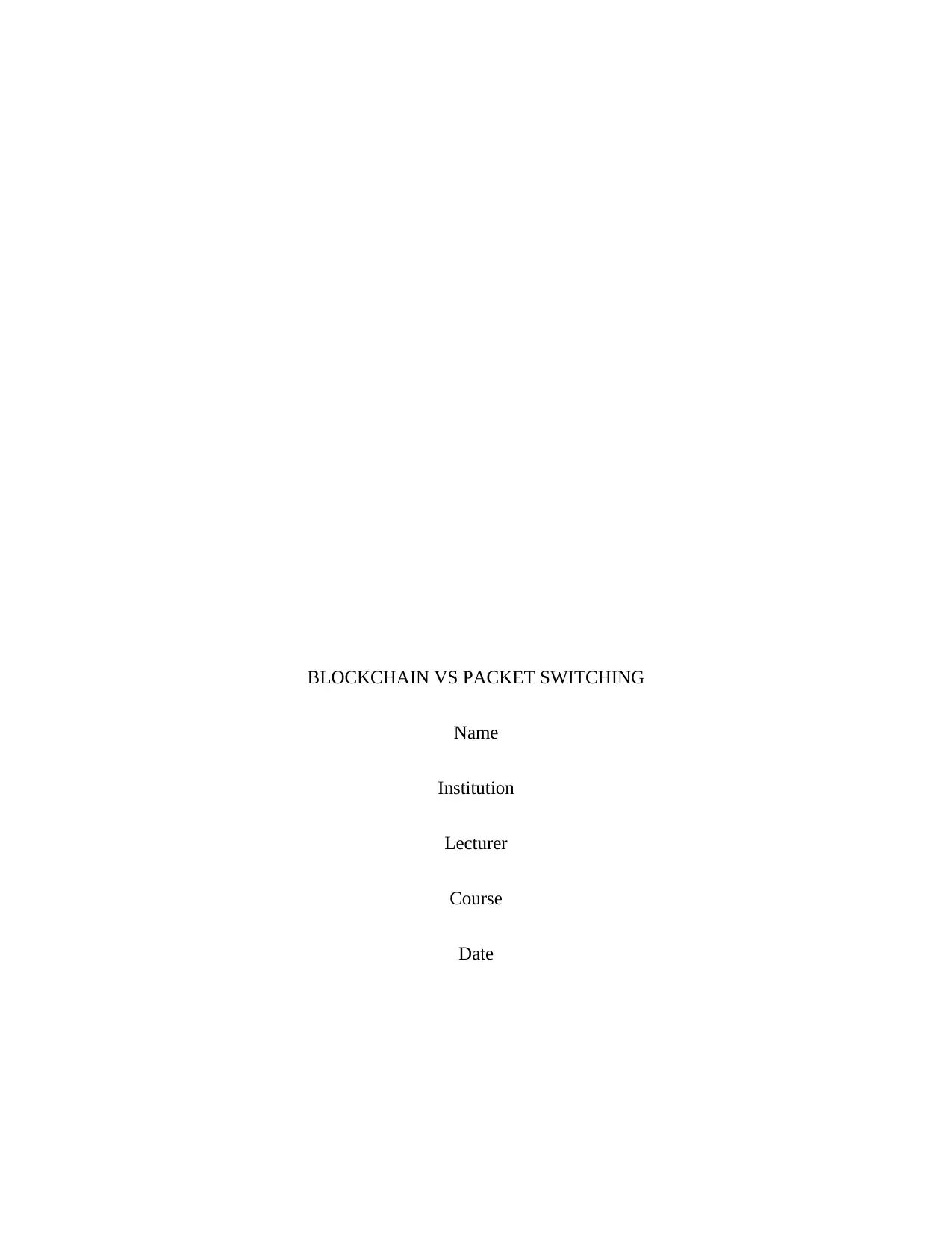
BLOCKCHAIN VS PACKET SWITCHING
Name
Institution
Lecturer
Course
Date
Name
Institution
Lecturer
Course
Date
Paraphrase This Document
Need a fresh take? Get an instant paraphrase of this document with our AI Paraphraser
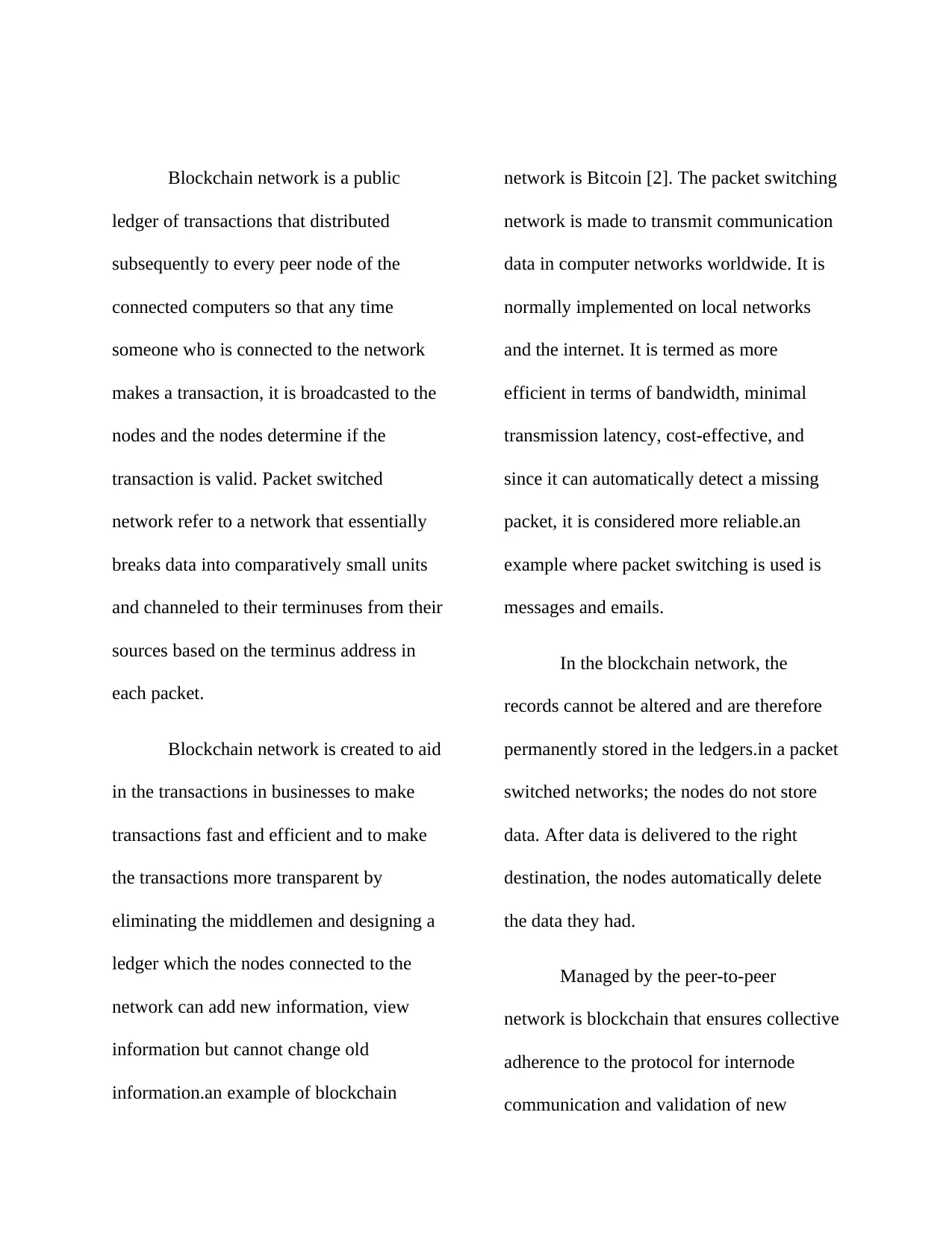
Blockchain network is a public
ledger of transactions that distributed
subsequently to every peer node of the
connected computers so that any time
someone who is connected to the network
makes a transaction, it is broadcasted to the
nodes and the nodes determine if the
transaction is valid. Packet switched
network refer to a network that essentially
breaks data into comparatively small units
and channeled to their terminuses from their
sources based on the terminus address in
each packet.
Blockchain network is created to aid
in the transactions in businesses to make
transactions fast and efficient and to make
the transactions more transparent by
eliminating the middlemen and designing a
ledger which the nodes connected to the
network can add new information, view
information but cannot change old
information.an example of blockchain
network is Bitcoin [2]. The packet switching
network is made to transmit communication
data in computer networks worldwide. It is
normally implemented on local networks
and the internet. It is termed as more
efficient in terms of bandwidth, minimal
transmission latency, cost-effective, and
since it can automatically detect a missing
packet, it is considered more reliable.an
example where packet switching is used is
messages and emails.
In the blockchain network, the
records cannot be altered and are therefore
permanently stored in the ledgers.in a packet
switched networks; the nodes do not store
data. After data is delivered to the right
destination, the nodes automatically delete
the data they had.
Managed by the peer-to-peer
network is blockchain that ensures collective
adherence to the protocol for internode
communication and validation of new
ledger of transactions that distributed
subsequently to every peer node of the
connected computers so that any time
someone who is connected to the network
makes a transaction, it is broadcasted to the
nodes and the nodes determine if the
transaction is valid. Packet switched
network refer to a network that essentially
breaks data into comparatively small units
and channeled to their terminuses from their
sources based on the terminus address in
each packet.
Blockchain network is created to aid
in the transactions in businesses to make
transactions fast and efficient and to make
the transactions more transparent by
eliminating the middlemen and designing a
ledger which the nodes connected to the
network can add new information, view
information but cannot change old
information.an example of blockchain
network is Bitcoin [2]. The packet switching
network is made to transmit communication
data in computer networks worldwide. It is
normally implemented on local networks
and the internet. It is termed as more
efficient in terms of bandwidth, minimal
transmission latency, cost-effective, and
since it can automatically detect a missing
packet, it is considered more reliable.an
example where packet switching is used is
messages and emails.
In the blockchain network, the
records cannot be altered and are therefore
permanently stored in the ledgers.in a packet
switched networks; the nodes do not store
data. After data is delivered to the right
destination, the nodes automatically delete
the data they had.
Managed by the peer-to-peer
network is blockchain that ensures collective
adherence to the protocol for internode
communication and validation of new
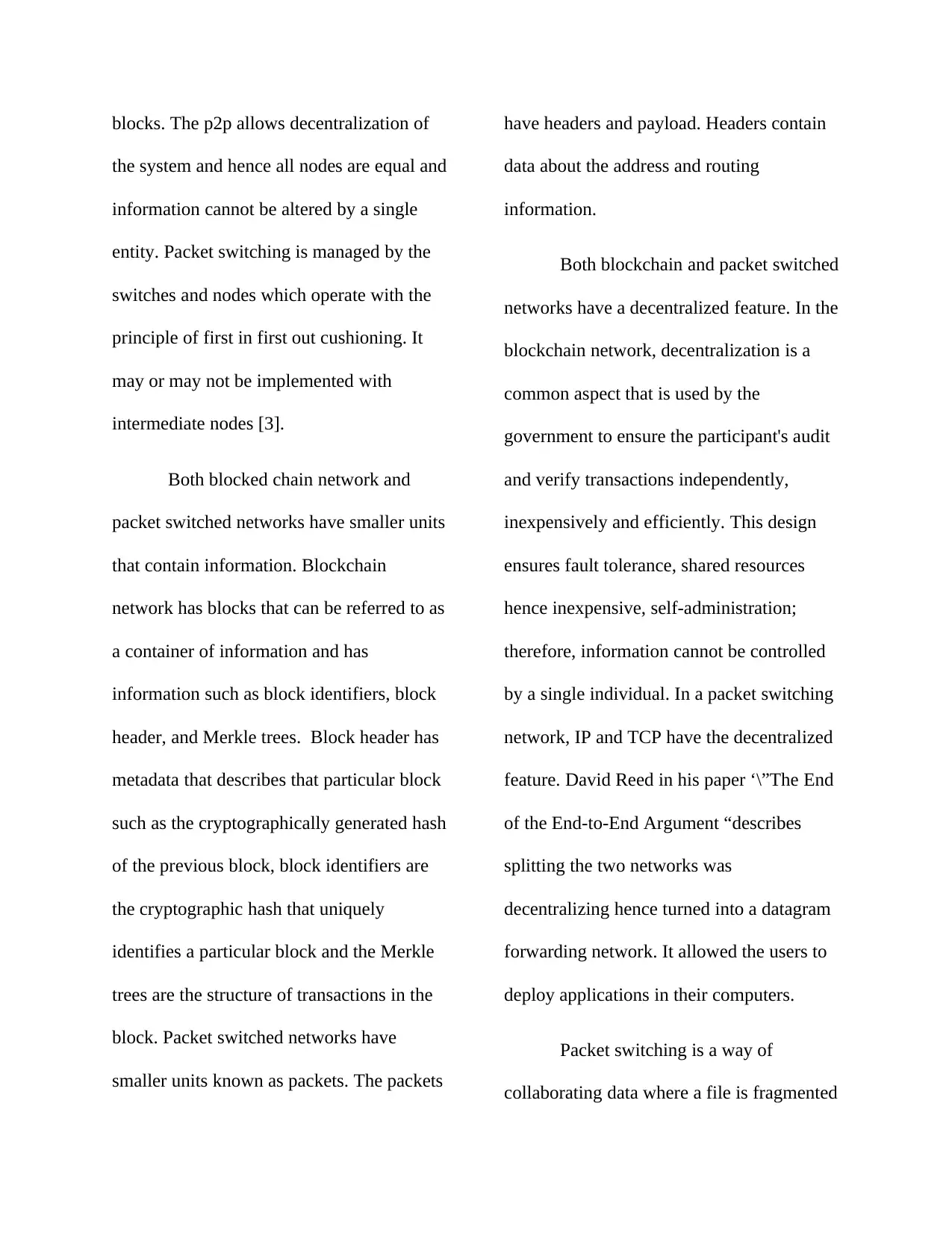
blocks. The p2p allows decentralization of
the system and hence all nodes are equal and
information cannot be altered by a single
entity. Packet switching is managed by the
switches and nodes which operate with the
principle of first in first out cushioning. It
may or may not be implemented with
intermediate nodes [3].
Both blocked chain network and
packet switched networks have smaller units
that contain information. Blockchain
network has blocks that can be referred to as
a container of information and has
information such as block identifiers, block
header, and Merkle trees. Block header has
metadata that describes that particular block
such as the cryptographically generated hash
of the previous block, block identifiers are
the cryptographic hash that uniquely
identifies a particular block and the Merkle
trees are the structure of transactions in the
block. Packet switched networks have
smaller units known as packets. The packets
have headers and payload. Headers contain
data about the address and routing
information.
Both blockchain and packet switched
networks have a decentralized feature. In the
blockchain network, decentralization is a
common aspect that is used by the
government to ensure the participant's audit
and verify transactions independently,
inexpensively and efficiently. This design
ensures fault tolerance, shared resources
hence inexpensive, self-administration;
therefore, information cannot be controlled
by a single individual. In a packet switching
network, IP and TCP have the decentralized
feature. David Reed in his paper ‘\”The End
of the End-to-End Argument “describes
splitting the two networks was
decentralizing hence turned into a datagram
forwarding network. It allowed the users to
deploy applications in their computers.
Packet switching is a way of
collaborating data where a file is fragmented
the system and hence all nodes are equal and
information cannot be altered by a single
entity. Packet switching is managed by the
switches and nodes which operate with the
principle of first in first out cushioning. It
may or may not be implemented with
intermediate nodes [3].
Both blocked chain network and
packet switched networks have smaller units
that contain information. Blockchain
network has blocks that can be referred to as
a container of information and has
information such as block identifiers, block
header, and Merkle trees. Block header has
metadata that describes that particular block
such as the cryptographically generated hash
of the previous block, block identifiers are
the cryptographic hash that uniquely
identifies a particular block and the Merkle
trees are the structure of transactions in the
block. Packet switched networks have
smaller units known as packets. The packets
have headers and payload. Headers contain
data about the address and routing
information.
Both blockchain and packet switched
networks have a decentralized feature. In the
blockchain network, decentralization is a
common aspect that is used by the
government to ensure the participant's audit
and verify transactions independently,
inexpensively and efficiently. This design
ensures fault tolerance, shared resources
hence inexpensive, self-administration;
therefore, information cannot be controlled
by a single individual. In a packet switching
network, IP and TCP have the decentralized
feature. David Reed in his paper ‘\”The End
of the End-to-End Argument “describes
splitting the two networks was
decentralizing hence turned into a datagram
forwarding network. It allowed the users to
deploy applications in their computers.
Packet switching is a way of
collaborating data where a file is fragmented
⊘ This is a preview!⊘
Do you want full access?
Subscribe today to unlock all pages.

Trusted by 1+ million students worldwide
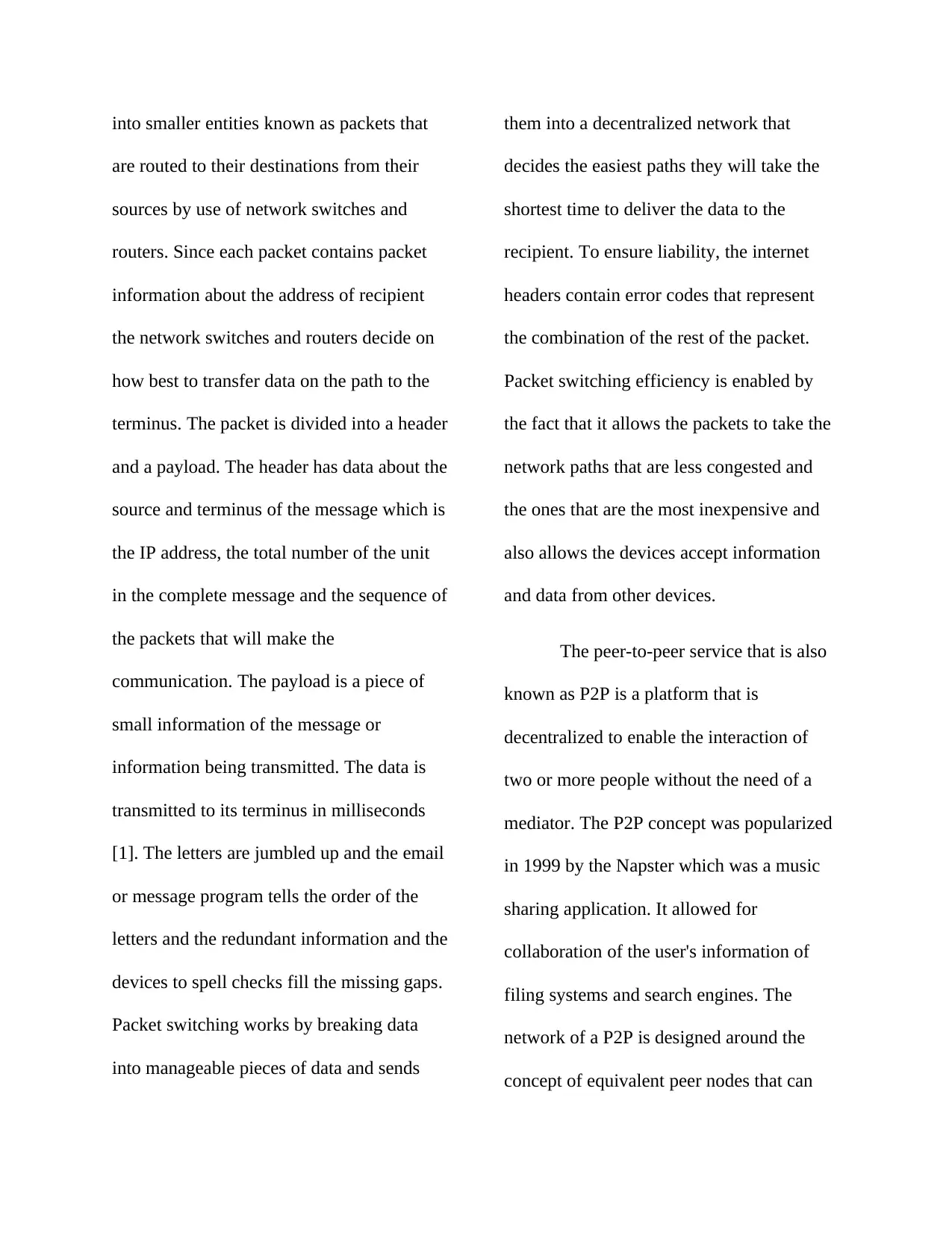
into smaller entities known as packets that
are routed to their destinations from their
sources by use of network switches and
routers. Since each packet contains packet
information about the address of recipient
the network switches and routers decide on
how best to transfer data on the path to the
terminus. The packet is divided into a header
and a payload. The header has data about the
source and terminus of the message which is
the IP address, the total number of the unit
in the complete message and the sequence of
the packets that will make the
communication. The payload is a piece of
small information of the message or
information being transmitted. The data is
transmitted to its terminus in milliseconds
[1]. The letters are jumbled up and the email
or message program tells the order of the
letters and the redundant information and the
devices to spell checks fill the missing gaps.
Packet switching works by breaking data
into manageable pieces of data and sends
them into a decentralized network that
decides the easiest paths they will take the
shortest time to deliver the data to the
recipient. To ensure liability, the internet
headers contain error codes that represent
the combination of the rest of the packet.
Packet switching efficiency is enabled by
the fact that it allows the packets to take the
network paths that are less congested and
the ones that are the most inexpensive and
also allows the devices accept information
and data from other devices.
The peer-to-peer service that is also
known as P2P is a platform that is
decentralized to enable the interaction of
two or more people without the need of a
mediator. The P2P concept was popularized
in 1999 by the Napster which was a music
sharing application. It allowed for
collaboration of the user's information of
filing systems and search engines. The
network of a P2P is designed around the
concept of equivalent peer nodes that can
are routed to their destinations from their
sources by use of network switches and
routers. Since each packet contains packet
information about the address of recipient
the network switches and routers decide on
how best to transfer data on the path to the
terminus. The packet is divided into a header
and a payload. The header has data about the
source and terminus of the message which is
the IP address, the total number of the unit
in the complete message and the sequence of
the packets that will make the
communication. The payload is a piece of
small information of the message or
information being transmitted. The data is
transmitted to its terminus in milliseconds
[1]. The letters are jumbled up and the email
or message program tells the order of the
letters and the redundant information and the
devices to spell checks fill the missing gaps.
Packet switching works by breaking data
into manageable pieces of data and sends
them into a decentralized network that
decides the easiest paths they will take the
shortest time to deliver the data to the
recipient. To ensure liability, the internet
headers contain error codes that represent
the combination of the rest of the packet.
Packet switching efficiency is enabled by
the fact that it allows the packets to take the
network paths that are less congested and
the ones that are the most inexpensive and
also allows the devices accept information
and data from other devices.
The peer-to-peer service that is also
known as P2P is a platform that is
decentralized to enable the interaction of
two or more people without the need of a
mediator. The P2P concept was popularized
in 1999 by the Napster which was a music
sharing application. It allowed for
collaboration of the user's information of
filing systems and search engines. The
network of a P2P is designed around the
concept of equivalent peer nodes that can
Paraphrase This Document
Need a fresh take? Get an instant paraphrase of this document with our AI Paraphraser
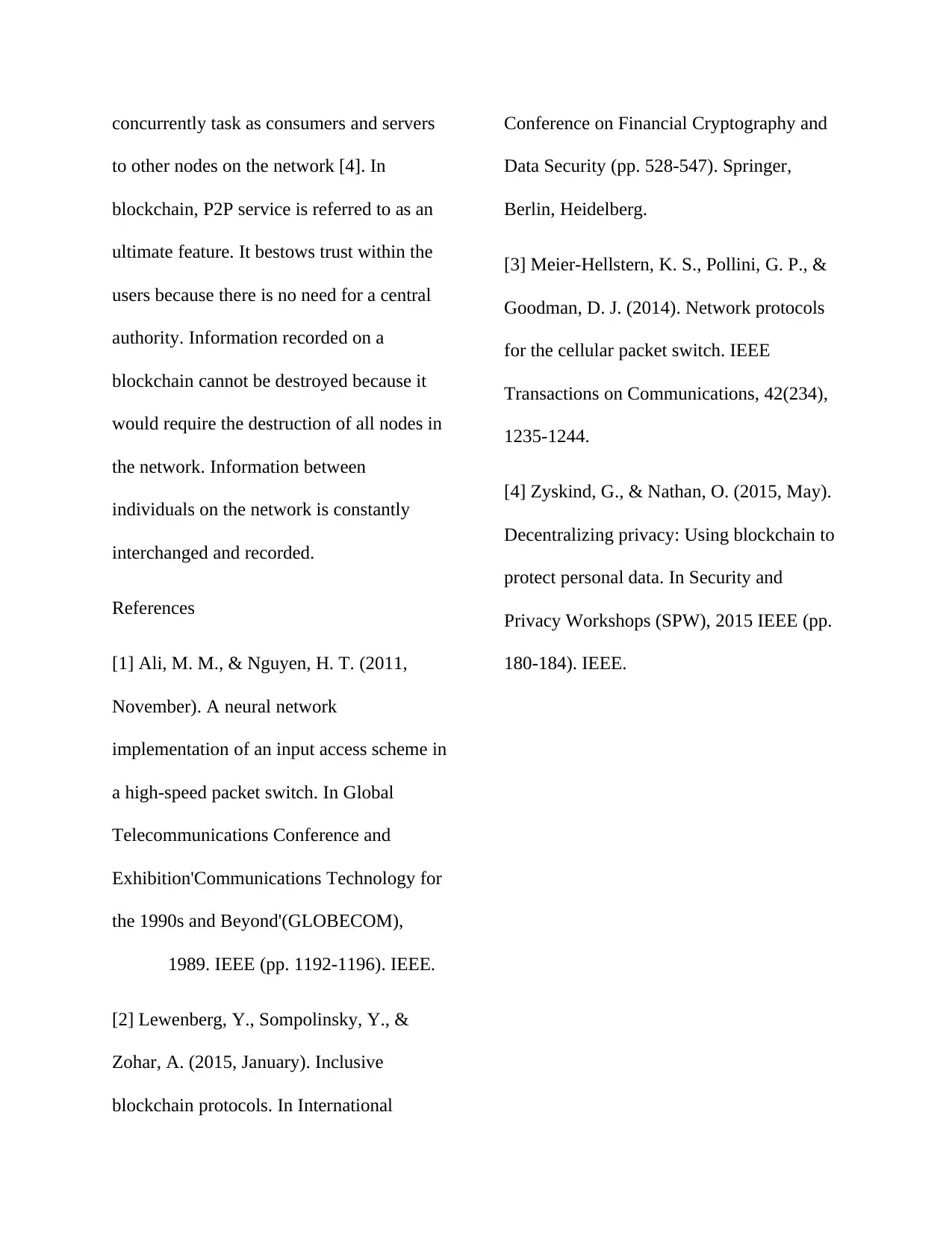
concurrently task as consumers and servers
to other nodes on the network [4]. In
blockchain, P2P service is referred to as an
ultimate feature. It bestows trust within the
users because there is no need for a central
authority. Information recorded on a
blockchain cannot be destroyed because it
would require the destruction of all nodes in
the network. Information between
individuals on the network is constantly
interchanged and recorded.
References
[1] Ali, M. M., & Nguyen, H. T. (2011,
November). A neural network
implementation of an input access scheme in
a high-speed packet switch. In Global
Telecommunications Conference and
Exhibition'Communications Technology for
the 1990s and Beyond'(GLOBECOM),
1989. IEEE (pp. 1192-1196). IEEE.
[2] Lewenberg, Y., Sompolinsky, Y., &
Zohar, A. (2015, January). Inclusive
blockchain protocols. In International
Conference on Financial Cryptography and
Data Security (pp. 528-547). Springer,
Berlin, Heidelberg.
[3] Meier-Hellstern, K. S., Pollini, G. P., &
Goodman, D. J. (2014). Network protocols
for the cellular packet switch. IEEE
Transactions on Communications, 42(234),
1235-1244.
[4] Zyskind, G., & Nathan, O. (2015, May).
Decentralizing privacy: Using blockchain to
protect personal data. In Security and
Privacy Workshops (SPW), 2015 IEEE (pp.
180-184). IEEE.
to other nodes on the network [4]. In
blockchain, P2P service is referred to as an
ultimate feature. It bestows trust within the
users because there is no need for a central
authority. Information recorded on a
blockchain cannot be destroyed because it
would require the destruction of all nodes in
the network. Information between
individuals on the network is constantly
interchanged and recorded.
References
[1] Ali, M. M., & Nguyen, H. T. (2011,
November). A neural network
implementation of an input access scheme in
a high-speed packet switch. In Global
Telecommunications Conference and
Exhibition'Communications Technology for
the 1990s and Beyond'(GLOBECOM),
1989. IEEE (pp. 1192-1196). IEEE.
[2] Lewenberg, Y., Sompolinsky, Y., &
Zohar, A. (2015, January). Inclusive
blockchain protocols. In International
Conference on Financial Cryptography and
Data Security (pp. 528-547). Springer,
Berlin, Heidelberg.
[3] Meier-Hellstern, K. S., Pollini, G. P., &
Goodman, D. J. (2014). Network protocols
for the cellular packet switch. IEEE
Transactions on Communications, 42(234),
1235-1244.
[4] Zyskind, G., & Nathan, O. (2015, May).
Decentralizing privacy: Using blockchain to
protect personal data. In Security and
Privacy Workshops (SPW), 2015 IEEE (pp.
180-184). IEEE.

⊘ This is a preview!⊘
Do you want full access?
Subscribe today to unlock all pages.

Trusted by 1+ million students worldwide
1 out of 6
Related Documents
Your All-in-One AI-Powered Toolkit for Academic Success.
+13062052269
info@desklib.com
Available 24*7 on WhatsApp / Email
![[object Object]](/_next/static/media/star-bottom.7253800d.svg)
Unlock your academic potential
Copyright © 2020–2025 A2Z Services. All Rights Reserved. Developed and managed by ZUCOL.




